Call +(254) 703 030 000 / 751 483 999 / 721 704 777
- Home
- Test Instruments
- Temperature And Environmental Measurement
- Temperature Probes Components
- Thermocouple Welders Accessories
.....Read More
Frequently Asked Questions
What is a thermocouple welder?
A thermocouple welder is a specialized device used to join the wires of a thermocouple, which is a sensor used to measure temperature. The welder creates a junction between two dissimilar metal wires, typically made from materials like iron, copper, nickel, or platinum, which are the basis of thermocouple types such as J, K, T, and others. This junction is crucial because it is the point where the thermoelectric effect occurs, allowing the thermocouple to generate a voltage that correlates to temperature.
The welding process typically involves a capacitive discharge method, where a high-current pulse is discharged through the wires to fuse them together. This method is preferred because it produces a strong, reliable junction with minimal thermal resistance, ensuring accurate temperature readings. The welder usually has adjustable settings to accommodate different wire sizes and materials, ensuring optimal weld quality.
Thermocouple welders are used in various industries, including manufacturing, aerospace, automotive, and electronics, where precise temperature measurement is critical. They are valued for their ability to produce consistent and repeatable welds, which are essential for the reliability and accuracy of thermocouples.
In summary, a thermocouple welder is an essential tool for creating the junctions necessary for thermocouples to function effectively, ensuring accurate temperature measurement across a wide range of applications.
How does a thermocouple welder work?
A thermocouple welder is a specialized device used to join two dissimilar metal wires to form a thermocouple junction, which is essential for temperature measurement. The process typically involves the following steps:
1. **Preparation**: The two metal wires, usually made from different materials like copper and constantan, are stripped of insulation at the ends to expose the bare metal. The ends are cleaned to remove any oxides or contaminants that could affect the weld quality.
2. **Clamping**: The prepared wire ends are placed in the welder's clamps or electrodes. These clamps hold the wires in place and ensure proper alignment for the welding process.
3. **Energy Application**: The welder uses a high-current, low-voltage electrical discharge to create a weld. This is often achieved through capacitive discharge, where a capacitor is charged to a specific voltage and then rapidly discharged through the wires. The sudden release of energy generates intense heat at the contact point, causing the metal to melt and fuse together.
4. **Fusion**: The heat generated by the electrical discharge causes the wire ends to melt and form a small, solidified bead upon cooling. This bead is the thermocouple junction, where the two metals are permanently joined.
5. **Cooling and Inspection**: After the weld is formed, it is allowed to cool naturally. The junction is then inspected for quality, ensuring it is free of defects like cracks or incomplete fusion, which could affect the thermocouple's performance.
6. **Testing**: The thermocouple is tested for continuity and resistance to ensure it functions correctly. Proper testing ensures that the thermocouple will provide accurate temperature readings.
Thermocouple welders are designed to produce consistent, reliable welds quickly, making them essential tools in industries where precise temperature measurement is critical.
What materials are needed for thermocouple welding?
Materials needed for thermocouple welding include:
1. **Thermocouple Wires**: The specific types of wires depend on the thermocouple type (e.g., Type K, J, T, etc.). These wires are made from specific metal alloys that determine the thermocouple's temperature range and sensitivity.
2. **Welding Machine**: A thermocouple welder, often a capacitive discharge welder, is used to join the wires. This machine provides the necessary energy to fuse the wires together.
3. **Electrodes**: Tungsten electrodes are commonly used in the welding process due to their high melting point and conductivity.
4. **Protective Gas**: In some cases, an inert gas like argon is used to shield the weld area from oxidation and contamination during the welding process.
5. **Insulation Materials**: After welding, the thermocouple junction may need to be insulated to prevent short circuits and protect against environmental factors. Common insulation materials include ceramic beads or fiberglass sleeves.
6. **Cleaning Supplies**: Cleaning agents like alcohol or acetone are used to clean the wire ends before welding to ensure a good quality weld.
7. **Safety Equipment**: Personal protective equipment (PPE) such as gloves, safety glasses, and protective clothing is necessary to ensure safety during the welding process.
8. **Support Tools**: Tools like wire strippers, cutters, and pliers are used to prepare the wires for welding.
9. **Calibration Equipment**: After welding, calibration equipment may be needed to verify the accuracy of the thermocouple.
These materials and tools are essential for creating a reliable and accurate thermocouple junction through welding.
Why is thermocouple carbon used in welding?
Thermocouple carbon is not typically used in welding. Instead, carbon electrodes or carbon arc welding are more relevant terms. Carbon electrodes are used in certain welding processes due to their high melting point, electrical conductivity, and ability to produce a stable arc. In carbon arc welding, a carbon electrode is used to create an electric arc between the electrode and the workpiece, generating intense heat that melts the metal and allows for joining.
The use of carbon in welding offers several advantages:
1. **High Temperature Resistance**: Carbon electrodes can withstand high temperatures without melting, making them suitable for welding applications that require intense heat.
2. **Stable Arc**: Carbon electrodes provide a stable and consistent arc, which is crucial for producing high-quality welds.
3. **Versatility**: Carbon arc welding can be used on a variety of metals, including steel, cast iron, and copper, making it a versatile choice for different welding tasks.
4. **Cost-Effectiveness**: Carbon electrodes are generally less expensive than other types of electrodes, such as tungsten, making them a cost-effective option for certain welding applications.
5. **Ease of Use**: The process is relatively simple and does not require complex equipment, making it accessible for various industrial and repair applications.
While carbon arc welding is not as commonly used as other methods like MIG or TIG welding, it remains a valuable technique for specific applications, particularly in repair work and situations where high heat is necessary.
How do you choose the right thermocouple welder?
To choose the right thermocouple welder, consider the following factors:
1. **Type of Thermocouple**: Ensure the welder is compatible with the specific thermocouple types (e.g., K, J, T) you intend to work with.
2. **Welding Method**: Decide between capacitive discharge and fusion welding. Capacitive discharge is suitable for fine wires, while fusion welding is better for larger wires.
3. **Material Compatibility**: Check if the welder can handle the materials of the thermocouple wires, such as nickel alloys or platinum.
4. **Wire Size**: Ensure the welder can accommodate the range of wire diameters you plan to use.
5. **Portability**: Consider a portable welder if you need to perform on-site welding.
6. **Ease of Use**: Look for user-friendly features like adjustable settings, intuitive controls, and clear displays.
7. **Power Supply**: Verify the power requirements and ensure compatibility with your available power sources.
8. **Durability and Build Quality**: Choose a welder with robust construction to withstand frequent use and harsh environments.
9. **Safety Features**: Ensure the welder has safety features like overload protection and insulated components.
10. **Cost**: Balance your budget with the features and quality you need. Consider long-term value over initial cost.
11. **Brand Reputation and Support**: Opt for reputable brands known for quality and customer support. Check for warranty and service options.
12. **Reviews and Recommendations**: Research user reviews and seek recommendations from industry professionals to gauge performance and reliability.
13. **Additional Features**: Consider additional features like foot pedals, adjustable pulse settings, or memory functions for specific applications.
By evaluating these factors, you can select a thermocouple welder that meets your specific needs and ensures efficient and reliable thermocouple production.
What are the safety precautions for using a thermocouple welder?
1. **Personal Protective Equipment (PPE):** Wear safety goggles, gloves, and flame-resistant clothing to protect against sparks and heat.
2. **Proper Ventilation:** Ensure the workspace is well-ventilated to avoid inhaling fumes or gases produced during welding.
3. **Equipment Inspection:** Regularly inspect the welder for any signs of damage or wear. Ensure all connections are secure and the equipment is functioning properly.
4. **Electrical Safety:** Verify that the power supply is appropriate for the welder. Use a grounded outlet and avoid using extension cords. Ensure all electrical components are insulated and free from damage.
5. **Fire Safety:** Keep a fire extinguisher nearby and ensure the work area is free from flammable materials. Be aware of the potential for sparks and take precautions to prevent fires.
6. **Work Area Organization:** Keep the work area clean and organized. Remove any unnecessary tools or materials that could cause accidents or interfere with the welding process.
7. **Training and Competence:** Only trained and competent personnel should operate the thermocouple welder. Understand the machine's operation manual and safety guidelines.
8. **Emergency Procedures:** Be familiar with emergency shutdown procedures and have a plan in place for dealing with accidents or equipment malfunctions.
9. **Avoid Moisture:** Ensure the work area and equipment are dry to prevent electrical hazards. Do not operate the welder in wet conditions.
10. **Proper Handling of Materials:** Handle thermocouples and other materials with care to avoid contamination or damage, which could affect the welding process.
11. **Calibration and Maintenance:** Regularly calibrate and maintain the welder to ensure accurate and safe operation. Follow the manufacturer's maintenance schedule.
12. **Use of Correct Settings:** Set the welder to the correct parameters for the specific materials and thermocouples being used to prevent overheating or damage.
How do you maintain and troubleshoot a thermocouple welder?
To maintain and troubleshoot a thermocouple welder, follow these steps:
1. **Regular Inspection**: Periodically check the welder for any visible signs of wear or damage, such as frayed wires, loose connections, or corrosion. Ensure all components are securely fastened.
2. **Calibration**: Regularly calibrate the welder to ensure accurate temperature readings. Use a standard reference thermocouple to compare and adjust the output.
3. **Cleaning**: Keep the welder clean and free from dust and debris. Use a soft brush or compressed air to clean the unit, especially around the welding tips and connectors.
4. **Check Connections**: Ensure all electrical connections are tight and free from oxidation. Clean contacts with a contact cleaner if necessary.
5. **Inspect Welding Tips**: Examine the welding tips for wear or damage. Replace them if they are worn out or not producing consistent welds.
6. **Test Functionality**: Regularly test the welder's functionality by creating sample welds and checking for consistency and strength.
7. **Monitor Power Supply**: Ensure the power supply is stable and within the specified range. Fluctuations can affect weld quality.
8. **Troubleshooting**:
- **Inconsistent Welds**: Check for loose connections, worn tips, or incorrect settings.
- **No Weld Output**: Verify power supply, check for blown fuses, and inspect internal wiring.
- **Overheating**: Ensure proper ventilation and check for obstructions in cooling fans.
9. **Documentation**: Keep a log of maintenance activities, calibration records, and any issues encountered for future reference.
10. **Manufacturer Support**: Consult the manufacturer's manual for specific maintenance guidelines and contact their support for unresolved issues.
By following these steps, you can ensure the reliable operation and longevity of your thermocouple welder.

